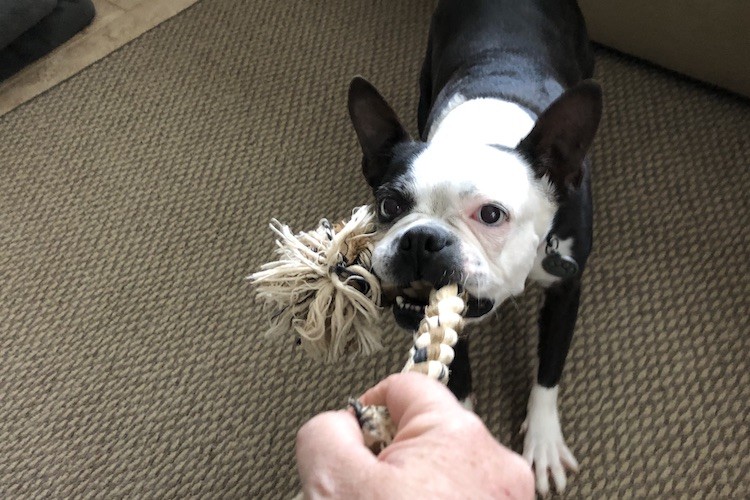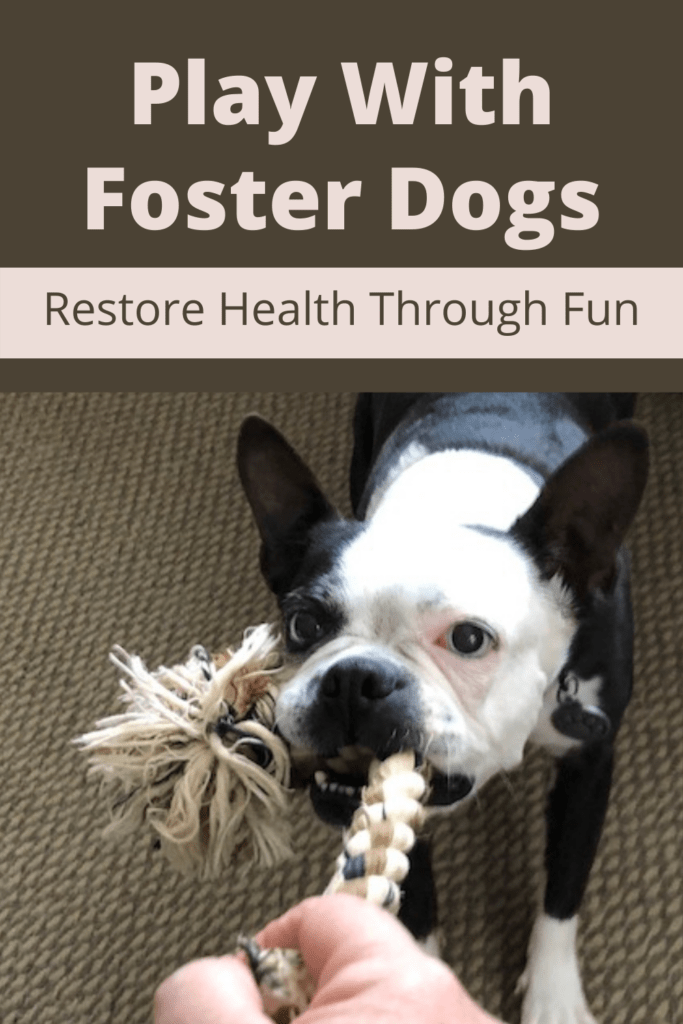Is play with foster dogs really that important?
Yup.
I have a master’s degree in play, and I spent a couple of decades helping humans learn how to play, discover more about themselves and others through play, and healing their illnesses through play.
Naturally, I believe our dogs benefit greatly from engaging in play. I believe it is essential that we play with foster dogs.
Indeed, every skill you and I learned as wee ones we learned through play. We learned to ambulate through play. We learned to eat solid food through play. We learned coordination, problem-solving, sharing, conflict resolution and many other skills through play. Engagement with another is often a part of play.
Watch a litter of puppies for a few weeks and you see that they too learn much of their world through play or seeking play.
I am not a veterinarian nor an animal behaviorist. I present my understanding of health or behavior issues based on personal experience and research I’ve done. If you have a dog with a health or behavioral issue, seek professional guidance. I hope you find my post useful.
The urge to play is not a strictly learned behavior, flowing from “higher centers” but rather reflects a deep instinctive fundamental need.
Stuart Brown, MD. National Institute For Play
How To Play With Rescue Dogs
Approach your dog with joy and fun and see what happens!
Our dogs respond to our voice, our facial expressions, and our body posture. When we approach them with fun and play, they become more responsive, more engaged, their focus toward us improves, and they are more motivated to do and be and learn.
Every interaction you have with your foster dog is an opportunity for fun and play. Make mealtimes fun. Can bath time be fun? You bet! House-training becomes so much easier when you provide timely play. You won’t successfully crate train your dog if you don’t use play.
Here are some benefits to playing with foster dogs.
Use play to build bonds with your foster dogs
We all have an emotional connection to our foster dogs, a connection we call “love.” Usually, it doesn’t take long before our foster dog’s face brightens and their tail wags when we enter the room.
At this early stage in the relationship, the dog is showing signs of happiness because they anticipate a reward of some kind: food, attention, praise. You are familiar to them, and every time you show up, something good happens. This reward-based relationship is not a bond. It is too soon.
A bond forms over time and is influenced by several factors, including safety, trust, and respect. A dog can love the attention you are giving, but not have a bond. Trust, respect, and security take time to develop. This is why so many dogs “get away” from their new owners in the first days after adoption. They love the attention, but they have not yet bonded.
Healthy play with your foster dog facilitates trust, respect, and security.
Play with foster dogs To enhance physical, mental, and emotional health
Play To Improve A Foster Dog’s Physical Health
Play is good for the body’s outside, play is good for the inside. You get to choose the game. Walks are play! Tug is play, so is fetch, catch, hide and seek, sit/stay/come, the list is long.
Play helps the cardiovascular system, helps activate any inactive muscles, promotes regularity with bowel and bladder and boosts the immune system.
Play Improves Mental Health
Choose a problem solving activity for your pup. It doesn’t have to be a puzzle toy or something inactive – games like tug and fetch are problem solving activities, too. A favorite activity at my house is hide and go seek! I recently introduced a new activity called a busy box. It is a perfect way to repurpose those empty boxed wine boxes!
Additionally, and I’ll cover this further down, when you are helping your foster dog practice their good manners, and you make that training fun and game-like, you’ve got a win-win.
For example, my foster dog Carter wanted to walk on our walks and sometimes his pace was not my pace, and vice versa. Creating a game during our walks kept the journey fun, less frustrating (for us both!) and Carter learned how to check in with me, his play partner.
Play Is Critical For A Foster Dog’s Emotional Health
When dogs have fun, they release all sorts of good brain chemicals and hormones and stuff. Stress chemicals that may have built up from time in the shelter or as a stray or from being in too many new places too close together begin to dissipate.
Play helps alleviate the day’s “trigger stacking” or the piling up of any little stress events that happened during the day.
You know what trigger stacking feels like, right? You’ve had a similar day: the company meeting was a waste of time. Your co-worker, Susan, was super annoying. The temperature in the office was FREEZING. On the way home, that jerk on the highway almost ran you off the road. The heel on your shoe broke and you forgot to take the roast out of the freezer this morning.
One more thing goes wrong and you are gonna blow.
What do you do? Go for a run or take a hot bath or meditate or phone a friend… you do a little self care.
Dogs have days like that, too. And play helps them feel better. It relieves the stress.
Ways to play with foster dogs
Teach the basics through play.
Good house-training protocols all include play. By asking a puppy to focus on potting first, the reward for “doing their business” is an opportunity to play. The same with adult dogs who need to learn how to potty outside. Once they “go,” they get praised. This is the perfect opportunity to let the dog play a quick game of fetch or tug-of-war.
Crate-training is also a basic skill that is much harder to teach if you aren’t using play along with food rewards. The quicker you teach the dog that crates are fun, the quicker they learn to love the crate, anytime, anywhere.
Leash skills and walking for exercise is a wonderful opportunity to play games with foster dogs. Instead of walking at the same pace, vary your speed while asking the dog to keep the leash tension soft. This game will help your dog learn to focus or “check-in” with you while walking.
I often played target games with Carter when we were out on walks so that I could help him better learn to keep the leash tension soft and to work on recall skills while working on a long line.
Turn manners training into fun games.
Promise promise promise. If you turn your manners training into fun and games, your foster dog will focus longer and learn quicker!
You DO have time to teach your foster dog good manners. You have time at mealtimes an every time you open the door to let the dogs out to potty or every time you attach the leash and every time you put dogs in and take them out of the crate.
Before you give your dog a treat, decide how you will make it fun and turn it into a training opportunity. If you just toss them a dog biscuit or plop down the food bowl, you’ve missed a training opportunity.
Building training games into your daily routine keeps your dogs interested in what you are doing, combats boredom, and helps you not feel so overwhelmed with your daily tasks. A few seconds here and there adds up! Plus, when you approach training as a game, you have fun, too.
Decide to add one game to one part of your daily routine and do this every day until it becomes a habit.
Improve everyone’s social skills!
Are you an introvert like me? Get this. 40% of dog owners surveyed said they made more social contacts when they were out with their dog.
That’s true for me. I interact more with my neighbors who have pets than with those who don’t. It’s probably because I remember dog names, not people names!
Depending upon my foster dog’s emotional skills, I may opt to walk the dog during a time of day I know a neighbor also walks, giving my dog an opportunity to practice sitting calmly for petting, or even practicing ignoring humans while out on a walk.
I also invite my dog-loving friends over to help foster dogs practice good manners with company. I’m able to teach others how to do the Canine Consent Test and my foster dogs are able to practice skills like “place,” sit nice for petting, and independence skills away from human conversation.
Relieve your stress, and the foster dog’s, too!
There is nothing more enjoyable to me than coming home after a less than awesome day and spending time with my dogs to shed all of that stress.
If you have any doubt that dogs reduce the stress in humans, just google it. There’s so much good content on this topic I really don’t need to repeat it here.
We are learning more and more about the stress levels in dogs and the impact of stress on their physical and mental health. Simply staying in a crate for a few hours while you are away, even when they are calm and relaxed, earns these pups the opportunity to play.
While I am a firm believer in using crates with dogs on a regular basis, I also know that we have to bring balance to the dog’s daily experiences. The more you ask a dog to stay calm in a crate, the more playtime you need to facilitate for the dog. Play is the perfect reward for being calm in a crate while you are away.

Play With Foster Dogs This Way. Or, How Not To Play With Foster Dogs.
Play Tug of War, Not Wrestle or rough-and-and tumble games. This includes tackle, grabbing the dog’s head, or any game that encourages the dog to grab your hand, arm, sleeve, pant leg, etc.
“I’ve been told that tug-of-war is not a safe game to play with foster dogs.”
We used to think that tug-of-war games were not safe games to play with dogs. We were told these types of games might encourage aggression in dogs or that dogs might challenge our dominance over them.
Now, research indicates that dogs simply enjoy the act of winning. It’s rewarding to win, isn’t it? I’ve even my dogs take turns “winning”!
Watch a game of tug and see what a dog does with the toy when it “wins” the round. Often, they bring it back to the human or dog and invite them to engage in another round. If this was a game of dominance, I don’t think a dog would bring the toy back.
Games To Play With Your Foster Dog
Play Lure Games instead of Hand Games – “The spider game” where your hand is cupped and fingers apart, sorta shaped like a spider? Don’t do that.
My mom played this game often with her dog. The objective of the game is for the dog to “get” the spider, aka hand. With the mouth. There are other variants to the game like ones that wave fingers in front of the dog’s face. Some think that these type of games help a fearful dog learn to trust hands. They don’t. Instead, they put the dog at incredible risk to bite.
Play lure games instead. Use a flirt pole or a toy on a long line. You can incorporate training into the game. Dogs can practice impulse control skills like “wait” or they can practice skills like “give it” “trade” or “release”.
If you want to teach your fearful foster dog that hands are nothing to be afraid of, use food rewards and target or “touch” games.
If your foster dog is very fearful (hiding, etc) you’ll want to read this
I challenge you to incorporate play into your daily interactions with your foster dog. Mealtime, walks, crate-training, house-training, and manners training are a few ways you can include play in training, which, by-the-way, will help your dog learn quicker!
Let me know how you are including play with foster dogs in your daily routine. I’d love to hear your stories. Have a challenge? I’ll try and help!

Extra Credit Reading
How Do You Play With Your Dog?
Human Play and Animal Play and Why We Are More Similar Than You Think
Three Myths About Playing With Your Dog
Popular Posts
- HOW TO CHOOSE A DOG RESCUE AGENCY
- ULTIMATE GUIDE TO FOSTERING: 10 SKILLS YOU NEED
- VOLUNTEER IF YOU CANNOT FOSTER


